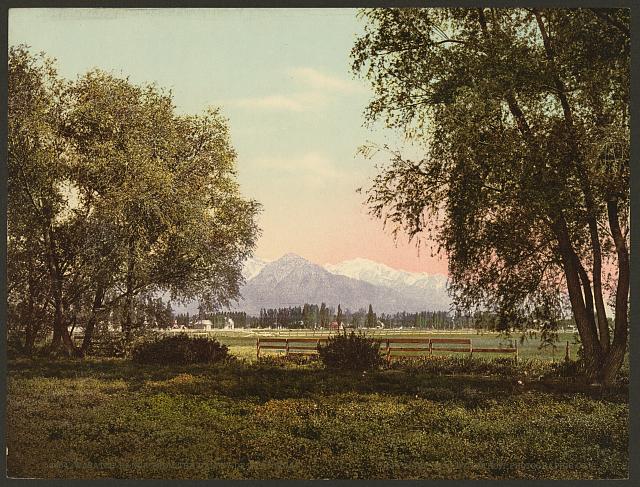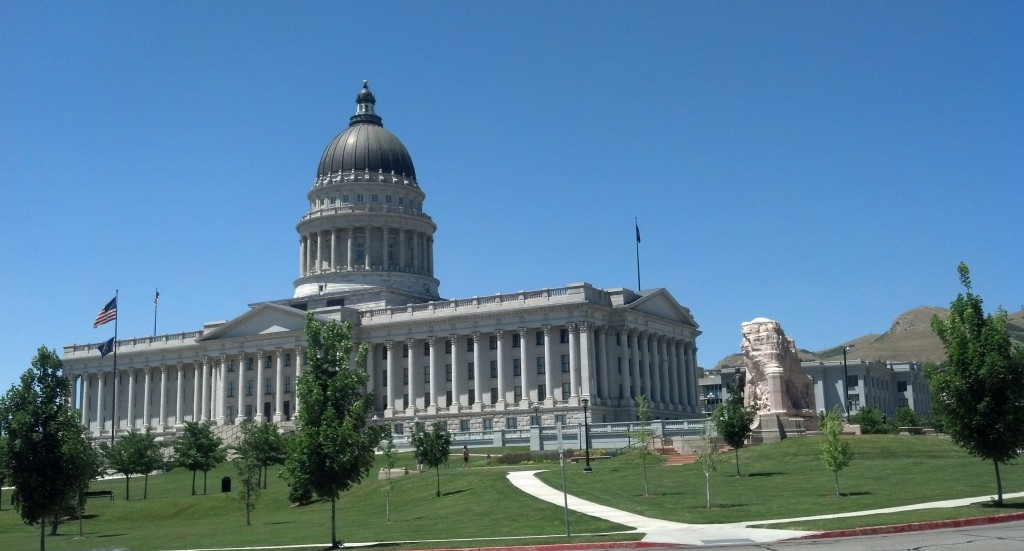
Salt Lake City, as seen in 1913 (Photo by Johnson Co. via the Library of Congress Prints and Photographs Division >>)
SALT LAKE CITY — There are only a handful of major cities in the United States where travelers get to enjoy a dramatic descent on a major highway down from the mountains into a broad urbanized valley below. Denver is probably the best example, where drivers headed east out of Colorado’s Front Range on Interstate 70 are presented not only with the vast expanse of the metropolitan area, but the endless horizon of the Great Plains beyond.
In Utah, I was expecting something similar heading down into Salt Lake City out of the Wasatch Range along Interstate 80. But Parleys Canyon only gives westbound drivers a partial glimpse of the Salt Lake Valley. This is a route that anyone who has skied or gone to the Sundance Film Festival in Park City has most likely experienced. The canyon narrows in its final stretch into Salt Lake City, so instead of seeing an uninterrupted view of the valley below, travelers are treated to a succession of exit signs for Interstate 215’s Belt Route amid the steep canyon walls with, in my case, bright blue skies above.
What was beyond briefly remained a mystery. When I popped out in South Salt Lake, the view wasn’t all that impressive. I could have been somewhere in Southern California.
Not counting my diversion to Boulder, Colo., Salt Lake City has been the largest populated area I’ve been in since I raced through the suburbs of Chicago, nearly 1,500 miles to the east.
When I rolled into Utah’s largest city, I wasn’t exactly inspired to declare “This is the right place,” as Brigham Young apparently said when his eyes first saw the Salt Lake Valley from the foothills of Emigration Canyon. But it was at least the right place to stop for lunch.
Post continues below …

The Wasatch Range seen from the Valley of the Jordan in a photomechanical print circa 1900 (Detroit Publishing Co. via the Library of Congress Prints and Photographs Division >>)
When the first Mormon pioneers arrived in the Salt Lake Valley in 1847, it was a barren landscape with just one lone cedar tree “tenaciously clinging to life in a desolate wasteland that the Mormons boast to have (according to scriptural prophesy, of course) resurrected to resplendent glory,” as this ex-Mormon blogger artfully but bluntly puts it.
The “Lone Tree” story was one taught to Utah schoolchildren for generations and the International Society of the Daughters of Utah Pioneers even built a monument to the tree in 1933, which reads:
Over this road the pioneers of 1847 and subsequent years entered the valley of the Great Salt Sea. They found growing near this site a lone cedar and paused beneath its shade. Songs were sung and prayers of gratitude offered by those early pilgrims. Later the cedar tree became a meeting place for the loggers going to the canyons, children played beneath its branches, lovers made it a trysting place. Because of its friendly influence on the lives of these early men and women we dedicate this site to their memory.
While early settlers did indeed transform the Salt Lake Valley into a hospitable place, the Lone Tree story is actually a myth. The cedar tree in question, which eventually died, was likely a juniper tree since cedar trees grow in southern Utah or at higher elevations in the vicinity of Salt Lake City, according to the Salt Lake Tribune.
Historians, however, have debunked the “Lone Tree” story “by citing any number of pioneer diaries that describe the valley as arid and dry in 1847 but definitely with its share of thirsty trees,” according to the Deseret News in July 2006.
The chairwoman of the International Society of the Daughters of Utah Pioneers, bemoaning the annual myth debunking during Pioneer Month, responded in a letter to the editor:
Calling the tree a “lone” tree does not mean that it was the “only” tree in the valley, but it must have stood out and been prominent enough that early travelers used it as a landmark and often a meeting place as they traveled down Emigration Street and on to the Pioneer Fort.
I suppose it’s fortunate for the early pioneers in Utah that Paul Bunyan didn’t come down Emigration Canyon to chop down the Lone Tree.
Post continues below …
***
Driving along Salt Lake City’s grid of broad thoroughfares downtown, I had the feeling that I could be in Denver with its modern skyscrapers, streetcar lines, convention center and shopping. The Utah State Capitol, finished in 1912, sits at the top of State Street. It’s one of those state capitol buildings that can easily stand in for the U.S. Capitol in Washington, D.C., in movies. (In fact, Legally Blonde 2: Red, White & Blonde was filmed there.)
The area around Temple Square, the home of the Church of Jesus Christ of Latter-Day Saints, shares some aesthetic qualities with the nation’s capital. It’s neat and tidy. The buildings, including the Salt Lake Temple, are meant to impress. The Church History Library looks like a more modest version of the Walter E. Washington Convention Center in D.C.
If there was any place I should have spent time in Salt Lake City, it was in Temple Square, but I had only allocated enough time to grab lunch and walk around a bit. I found a parking garage near the very Romanesque-looking Salt Lake City and County Building, a structure that rivals the great Salt Lake Temple in architectural grandeur.
As I was waiting at a crosswalk at the corner of State Street and Broadway, a slightly disheveled man in a non-motorized wheelchair approached me. He looked homeless and I thought I would be solicited for money.
“Do you know where the library is? I need to get on the Internet.”
“Actually, I’m not from here,” I replied as I pulled out my smartphone. “But I can probably figure it out on my phone.”
“Gaaaa. Nooo! You’re not Dr. Beverly Crusher,” he exclaimed in horror, referring to the chief medical officer from Star Trek: The Next Generation, who like most Starfleet officers, carried a smartphone-like tricorder device.
The crosswalk signal turned from “Don’t Walk” to “Walk” and the man in the wheelchair started moving across the street. I followed. He turned to me with a really nasty look on his face.
“You’re one of them! You’re one of Obama’s spies! You people are everywhere!“
My first thought was that this guy wasn’t totally crazy. All along my trek along the Lincoln Highway, the major news day after day was some variation on the story involving the National Security Agency leaks by Edward Snowden.
I suppose that my smartphone could have been used as a spying device by the NSA but I highly doubt that any NSA analyst back in the Maryland suburbs was interested in the man in the wheelchair or my Lincoln Highway trip. (And if they have been following my cross-country trip, I hope it’s been both educational and entertaining!)
The time I scheduled for Salt Lake City was rapidly running out. I needed to press west across the Bonneville Salt Flats and eventually Ely, Nev., and I was hungry.
I hadn’t done any research into places to eat, so I picked a random place called East Coast Subs on Broadway and had a meaty but otherwise unremarkable Philly cheesesteak. (In hindsight, I should have sought out a pastrami burger at Crown Burgers, or, perhaps, Jell-O, which is a Mormon favorite.)
I sat down adjacent to a crew of high-rise window washers. Two of them had their smartphones in one hand and their subs in the other. Perhaps they too were spies for President Obama.


Great… You finally talk to someone and they are crazy. Ah, America!
Pingback: The Best Beach So Far This Year? | The Lincoln Highway Guide